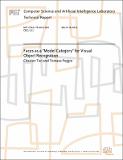Browsing Computer Science and Artificial Intelligence Lab (CSAIL) by Title
Now showing items 1207-1226 of 3804
-
Face Detection in Still Gray Images
(2000-05-01)We present a trainable system for detecting frontal and near-frontal views of faces in still gray images using Support Vector Machines (SVMs). We first consider the problem of detecting the whole face pattern by a single ... -
Face processing in humans is compatible with a simple shape-based model of vision
(2004-03-05)Understanding how the human visual system recognizes objects is one of the key challenges in neuroscience. Inspired by a large body of physiological evidence (Felleman and Van Essen, 1991; Hubel and Wiesel, 1962; Livingstone ... -
Face processing in humans is compatible with a simple shape-based model of vision
(2004-03-05)Understanding how the human visual system recognizes objects is one of the key challenges in neuroscience. Inspired by a large body of physiological evidence (Felleman and Van Essen, 1991; Hubel and Wiesel, 1962; Livingstone ... -
Face Recognition from One Example View
(1995-09-01)If we are provided a face database with only one example view per person, is it possible to recognize new views of them under a variety of different poses, especially views rotated in depth from the original example ... -
Face Recognition Under Varying Pose
(1993-12-01)While researchers in computer vision and pattern recognition have worked on automatic techniques for recognizing faces for the last 20 years, most systems specialize on frontal views of the face. We present a face recognizer ... -
Face Representation in Cortex: Studies Using a Simple and Not So Special Model
(2003-06-05)The face inversion effect has been widely documented as an effect of the uniqueness of face processing. Using a computational model, we show that the face inversion effect is a byproduct of expertise with respect to the ... -
Faces as a "Model Category" for Visual Object Recognition
(2013-03-18)Visual recognition is an important ability that is central to many everyday tasks such as reading, navigation and social interaction, and is therefore actively studied in neuroscience, cognitive psychology and artificial ... -
Facilitating Interprocess Communication in a Heterogeneous Network Environment
(1977-07)Passing information among processors with different internal data formatting schemes has proven to be a major complication to computer networking efforts. Data format translation is necessary to support information exchange ... -
Factorial Hidden Markov Models
(1996-02-09)We present a framework for learning in hidden Markov models with distributed state representations. Within this framework, we derive a learning algorithm based on the Expectation--Maximization (EM) procedure for maximum ... -
Factoring Numbers in 0(log n) Arithmetic Steps
(1977-11)In this paper we show that a non-trivial factor of a composite number n can be found by performing arithmetic steps in a number proportional to the number of bits in n, and thus there are extremely short straight-line ... -
Factors Affecting the Adoption of Faculty-Developed Academic Software: A Study of Five iCampus Projects
(2007-10-20)Instruction in higher education must adapt more rapidly to: changes in workforce needs, global issues, advances in disciplines, and resource constraints. The pace of such improvement depends on the speed with which new ... -
Factors Affecting the Adoption of Faculty-Developed Academic Software: A Study of Five iCampus Projects
(2007-08-20)Initiated in 1999, iCampus is a research collaboration between Microsoft Research and MIT whose goal is to create and demonstrate technologies with the potential for revolutionary change throughout the university curriculum.” ... -
The Facts of Light
(MIT Artificial Intelligence Laboratory, 1975-05)This is a random collection of facts about radiant and luminous energy. Some of this information may be useful in the design of photo-diode image sensors, in the set-up of lighting for television microscopes and the ... -
Failsafe Key Escrow
(1994-08) -
Failsafe Key Escrow Systems (Extended Abstract)
(1994-08)This paper describes a method for escrowing cryptographic keys, which we call Failsafe Key Escrow (FKE). The method is substantially more secure than alternative such as the Fair Public Key Cryptosystem approach advocated ... -
Fair Cryptosystems
(1993-11) -
A Fair Power Domain for Actor Computations
(MIT Artificial Intelligence Laboratory, 1979-06)Actor-based languages feature extreme concurrency, allow side effects, and specify a form of fairness which permits unbounded nondeterminism. This makes it difficult to provide a satisfactory mathematical foundation for ... -
Family Values: A Beahvior Notion of Subtyping
(1993-08) -
Fan-beam Reconstruction Methods
(1977-11-01)In a previous paper a technique was developed for finding reconstruction algorithms for arbitrary ray-sampling schemes. The resulting algorithms use a general linear operator, the kernel of which depends on the details ...



















